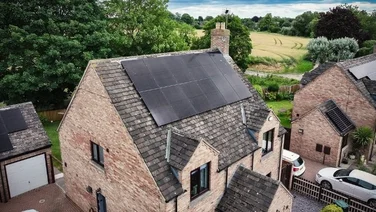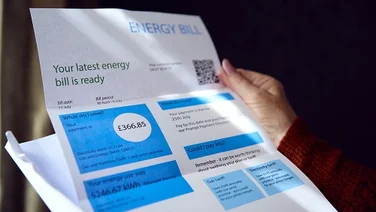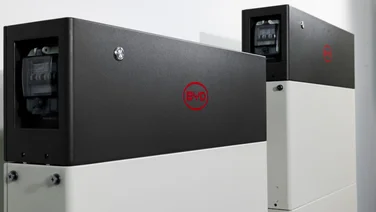- Make sure your home is well insulated
- Use heating controls
- Invest in a heat pump
- Switch to low-energy or LED lighting
- Check your appliances
- Switch to solar energy
- Rethink your travel choices
- Consider driving an electric car
- Upgrade your windows
- Reduce food waste
- Increase your recycling efforts
- Shop your wardrobe
- The global average carbon footprint is around 4.7 tonnes of CO2 per person
- The UK aims to reduce carbon emissions to net zero by 2050
- Insulation, heat pumps and solar panels are larger investments to reduce carbon emissions
- Cost-effective ways to reduce your carbon footprint include switching to LED lighting and recycling
The global average energy-related carbon footprint is around 4.7 tonnes of CO2 per person, according to the International Energy Agency. This is the equivalent of taking two-round trip flights between Singapore and New York.
With each country committing to their own net zero emissions targets, sustainability is high on the agenda. The UK, for example, aims to reduce all direct carbon emissions from public sector buildings by 50% and 75% by 2032 and 2037 respectively and all UK emissions are to reach net zero by 2050.
But there are ways you can help your residing country meet these goals. Small changes will result in a bigger impact.
According to the 2024 National Home Energy Survey, 12% of people believe that individual actions will have a significant impact on climate change. A further 31% of the UK public believe that individual actions have some impact, but they are not enough with major efforts from big companies and governments.
To read more about public opinion on climate change and what can be done to prevent it, download the NHES survey here.
National Home Energy Survey 2024
Read the full findings from this year’s report by downloading the PDF here
In this guide, we’ve highlighted 12 ways to help reduce your carbon footprint. These range from cost-effective options you can implement almost instantly to ones that require a larger investment.

Make sure your home is well insulated
Insulation helps keep your home warmer in winter and cooler in summer, reducing the need for other means of heating and cooling.
But there are different kinds of insulation to choose from:
- Loft insulation – installed in your loft or attic space
- Cavity wall insulation – installed inside the gap (cavity) between an internal and external wall
- Floor insulation – installed below or above the floor surface
- Fibreglass insulation – a type of insulating material made of plastic reinforced by tiny glass fibre
- Foil insulation – a type of insulation incorporating a reflective foil layer (usually aluminium) to reflect radiant heat
- Wall insulation – applied over the inner or outer surface of a solid wall
- Roof insulation – installed between and over the roof rafters
Most homes will have insulation installed, particularly newer builds, but if you’re in an older home, it might be worth the investment.
If you’re interested in insulating your home, fill out our form and we’ll put you in touch with expert installers who will be able to provide more detailed advice.

How much does it cost to insulate my home?
The cost of insulation will be dependent on varying factors, like the type of home you have.
For example, a terraced house for loft insulation costs can be anywhere between £125-£1,720 for the insulation material and a further £150-£400 per day for labour costs. Meanwhile, a bungalow would cost between £375-£1,200.
The cost of installation is also impacted by ease of access, removal of any existing insulation, electrical wiring and whether or not a loft hatch or ladder needs to be installed.
We recommend getting insulation quotes from three or more different suppliers, comparing quotes and labour costs before making your final decision.
From here, check customer reviews on Google or TrustPilot to help you choose the company that you want to do the job.
Use heating controls
Heating the places we live and work in accounts for nearly half of all energy consumption and 40% of energy-related carbon dioxide emissions.
The easiest way to cut your carbon footprint is to take ownership and control of your heating, and not using more than you need.
You’ll need a timer or programmer if you have a central heating system, as well as a room thermostat. There are also smart heating controls available for all types of heating systems.
Some examples include the Google Nest Thermostat, which has an average cost of around £160-£190. There are cheaper alternatives, like the Stand for the Google Nest Learning Thermostat, which has an average cost of £30-£40.
Other brands include Hive Thermostat, ESi and Honeywell.
This will allow you to set your heating to a certain temperature, but also give you control to increase it as needed.
Invest in a heat pump
A heat pump is a machine that draws heat from outside, whether that be the air, ground or water, and then uses it to heat your home and its hot water system.
Soon, they will become a common feature of homes and can save you money on your bills.
You’ll also typically cut your carbon footprint by 44% and be futureproofed against the gas boiler phaseout. Heat pumps also last up to 35 years if you install an air source pump – a 22 year increase on the average 13 years for a gas boiler.
They are also low maintenance.
Each heat pump works differently, so check out our guide: What is a heat pump? to better understand what’s right for you. Or listen to heat pump expert, Bean Beanland, break it all down for you on the Positive Energy podcast episode, What the hell is a heat pump?

How much does a heat pump cost?
Heat pumps cost anywhere between £7,000 and £35,000. The price you pay will be dependent on the type of heat pump you want, the system size and how many bedrooms you have.
For example, a three-bedroom home will need a 10kW air source heat pump or an 8kW ground source heat pump. The air source, on average, will cost approximately £10,000, while ground source will set you back around £24,000, on average.
This doesn’t include installation fees either, however, homeowners and landlords might qualify for the Boiler Upgrade Scheme. The scheme can help reduce the cost of a heat pump by £7,500.
What’s more, the guidelines to qualify for the scheme changed earlier this year. You no longer need a cavity wall or loft insulation, meaning more are able to take advantage of the scheme.
Switch to low-energy or LED lighting
On average, a household in the UK will have around 34 light bulbs, each using energy and adding to your home lighting bills, according to Evergreen Energy.
Its website says: “Currently, the average home is spending £77 on lighting, making up 18% of annual energy bills. LED technology is the next best option to turning off a switch.”
LED lighting uses about 75% less energy than halogen light bulbs and lasts five-to-10 times longer. According to Evergreen Energy, a 50W halogen spotlight can be replaced by a 5W LED, which is 90% less energy use resulting in a significant reduction in CO2 production.
“The longer lifespan of LED bulbs means less bulbs need to be produced, resulting in less waste and energy use in building new technologies,” the manufacturer said.
And Evergreen Energy claims that in three months, you’ll spend more with your energy supplier than you would on buying a new LED light bulb.
Check your appliances
When buying new appliances, choosing energy efficient appliances will help reduce your overall carbon footprint.
As noted by the Energy Saving Trust, cooking, cooling or freezing, and wet appliances typically account for 13% of an average household’s energy consumption.
Rather than overhauling all your appliances, simply lowering the temperature can help. With washing machines, for example, a lot of models have an eco setting or washing your clothes at a lower temperature will reduce your carbon footprint.
Similarly, using a clothes airer over the tumble dryer will reduce energy consumption and your carbon footprint, lowering your monthly bills.
If you’re in need of new appliances, however, then choose a model with a high energy efficiency rating to lower your home’s carbon footprint.
Switch to solar energy
Solar energy can save you between £289 to £675 per year on your energy bills, while reducing carbon emissions. This is because solar power doesn’t produce any emissions during generation itself.
There are two main types of solar energy: photovoltaic (PV) and thermal. PV systems convert sunlight directly into electricity. Thermal solar systems use the sun’s heat to warm up water.
These materials are used for panels that sit on the roof, but tiles are becoming popular as they can be more aesthetically pleasing for your home.
The average three-bedroom home will need 10 panels to match its average usage of 2,700kWh. The 10 panels will generate around 2,645kWh.

Can solar panels save me money?
Ultimately, yes. The average UK domestic installation costs around £9,180. The price will vary depending on location, system type, number of panels and the size of your home.
The savings you can make each year range from around £289 to £675 thanks to the Smart Export Guarantee. However, with the large investment required to install solar panels, it can take up to or more than 15 years to break even.
Solar panels do have a lifespan of 25-30 years, so you will make a profit of up to £7,060.
The expense can be high, but luckily, there are grants available to help lower the initial cost. These include the ECO4 scheme, Solar Together, Home Energy Scotland Loan, and the Warm Homes Local Grant. Before March 2025, this also included the now-defunct Home Upgrade Grant.
For a full rundown on costs, check out our guide on how much solar panels cost in the UK where we cover costs, factors that impact costs and how to reduce costs.
Similarly, for more information on eligibility requirements and how to apply for these schemes, check out our guide to solar panel grants, too.
Rethink your travel choices
Deciding to walk or cycle to the shops instead of driving will have a massive impact over time, as well as improving your own health.
If you live in major cities, like London, Liverpool or Manchester, you can rent a cycle or scooter. They are typically located in town centres and can be paid for via an app.
Alternatively, if you have to drive, consider investing in an electric car.
Consider driving an electric car
Electric vehicles (EV) are an investment, but they can help lower your carbon footprint. This is because EVs produce no carbon dioxide emissions when driving, thanks to the fact it’s powered by batteries alone.
You’ll also save money compared to a petrol car.
According to UK government data, the average cost of running a 100% electric car is 9p per mile. When comparing this to petrol and diesel cars, EVs can save you anywhere between 2p and 15p per mile. The savings will depend on the vehicle’s engine size for diesel and petrol cars.
As part of this investment, there’s an option to install an EV charger at home. Of course, you can drive to a public charging point, where there are now more than 60,000 EV charging points across the UK.
Below, we look at how much an at-home EV charger will cost you.

How much do EV charging points cost?
An EV charging point costs £1,000 on average and can save you around £664 per year. It’s also the most cost-effective choice than travelling to public charging points, as this will vary on your location and which station your travel to. The charger’s power rating will also impact the price.
At home, there are some financing options available. If you own your home or are in rental accommodation, you might be able to claim 75% off the cost to buy and install a socket, up to a maximum of £350 from the Office for Zero Emission Vehicles (OZEV) towards the final cost.
Before installing, EDF Energy recommends thinking about how it will impact the cost of your energy bills. Its website says if you travel 8,000 miles per year, this might equate to 2,800kWh of additional electricity your annual bill if 1kWh equals 2.5 miles.
“It pays to look for the right energy traffic,” the energy supplier states. “For example, you might want to look at off-peak prices, as many energy companies offer lower electricity prices at night when the demand on the grid is reduced and energy prices are cheaper.”
Upgrade your windows
Having the right windows for your property can help your home stay warm in the winter and cooler in the summer. This will then help lower your carbon footprint, as you won’t need to use your heating as often.
There’s two main options to choose from if you’re looking to upgrade: Double and triple glazing.
Double glazing costs less than triple glazing, costing between £600 and £3,600 per window. Meanwhile, triple glazing costs up to £4,320 per window. Installation costs are around £250 for a day’s work, so more windows means more time to install.
Grants are available, including the ECO4 and the Warm Homes Local Grant. For a full rundown on what’s available, check out our guide on double glazing grants. Prior to March 2025, the Home Upgrade Grant could also have helped with the cost, but it is now closed to new applications.

Reduce food waste
The UK throws away around 9.5 million tonnes of food waste each year, which can be reduced by simply avoiding food waste.
You can achieve this by freezing what you won’t use for a late date or plan your meals ahead of time. Some can even be used as leftovers for the following day.
If you live alone or simply don’t want to buy a family-sized bag and product, a company called Field Fayre provides single-product frozen foods, which include pastries.
Meal prep will also reduce food waste, thus having less of an impact on your carbon footprint because less is going into landfill.
Increase your recycling efforts
Recycling is a highly effective way to reduce your environmental impact. Most of the time, it’s free, too.
The challenge for many is recycling at home can be a struggle. Thankfully, the UK government is working to reduce this confusion.
From 9 May, new recycling collections were introduced. Councils will now be allowed to collect plastic, metal, glass, paper and card in one bin in all circumstances. Food and garden waste will also be allowed to be co-collected.
Some items will need to be taken to other recycling plants, like bags for life, but this update will make it easier to recycle and lower your carbon footprint.
Shop your wardrobe
Eighty-five per cent of all textiles end up in landfill every year, which is the equivalent of 81.5 pounds (37kg) per person per year.
Sites like Vinted and Depop are helping to reduce this every year, as it gives consumers the chance to shop secondhand and buy pre-loved. Charity shops are also good ways of ensuring clothes don’t end up in landfill.
Alternatively, shop your own wardrobe. Social media has given us all ideas to mix and match our wardrobes to avoid clothes going into landfill. Summary
- Insulation helps keep your home warmer in winter and cooler in summer, reducing the need for other means of heating and cooling
- A terraced house for loft insulation can pay anywhere between £125-£1,720 for the insulation material and a further £150-£400 per day for labour costs
- Heats pumps typically cut your carbon footprint by 44% and be futureproofed against the gas boiler phaseout
- Heat pumps cost anywhere between £7,000 and £35,000
- According to UK government data, the average cost of running a 100% electric car is 9p per mile
- Meal prep will also reduce food waste, thus having less of an impact on your carbon footprint because less is going into landfill
- Recycling is a highly effective way to reduce your environmental impact. Most of the time, it’s free, too







